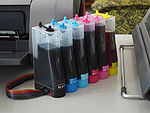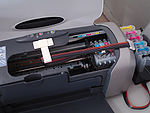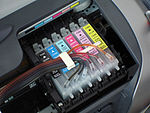This is an old revision of this page, as edited by 182.239.131.104 (talk) at 10:57, 30 April 2011. The present address (URL) is a permanent link to this revision, which may differ significantly from the current revision.
Revision as of 10:57, 30 April 2011 by 182.239.131.104 (talk)(diff) ← Previous revision | Latest revision (diff) | Newer revision → (diff)| This article does not cite any sources. Please help improve this article by adding citations to reliable sources. Unsourced material may be challenged and removed. Find sources: "Continuous ink system" – news · newspapers · books · scholar · JSTOR (February 2008) (Learn how and when to remove this message) |




A continuous ink system (CIS), also known as a continuous ink supply system (CISS), a continuous flow system (CFS), an Automatic Ink Refill System (AIRS), bulk feed ink system, or an off-axis ink delivery system is a method for delivering a large and practically unlimited volume of liquid ink to a comparatively small inkjet printhead. Many business and professional grade printers incorporate a continuous ink system in their design to increase the speed and volume of printing capacity. Some aftermarket companies also build retrofit accessories to convert certain models of consumer-grade printers into continuous flow systems.
Comparison to the tank-on-printhead design
Most low-cost consumer printers place small ink tanks directly on the carriage with the printheads. These tanks can have extremely small liquid volumes, as low as 10 mL, and consequently require frequent replacement. More expensive business-grade printers use progressively larger ink tanks on the printhead, but as the platen width and speed of the printer increases it eventually becomes impractical to have the tanks integrated with the printheads due to the high mass and inertia the liquid volume adds to the printheads and the reduced accuracy of printing that occurs.
Separating the ink storage from the printhead also allows the tank to be refilled or replaced while a print job is in progress. With ink tanks located on the printhead, replacement typically requires repriming and alignment checks that necessarily require aborting any current print job. Separated ink tanks can be refilled or reprimed without disrupting a very large or expensive printing task, such as printing a 2 meter wide by 10 meter long outdoor banner.
Retrofit accessory kits
Many CIS systems have been developed to cover most Epson, HP, Canon, and other printers. These bulk feed systems also allow users to use inexpensive aftermarket inkjet inks as well as specialty inks for T-Shirt transfers or Black and White inks for B&W printing. These options have allowed users to produce specialty prints at a fraction of the cost of purchasing special cartridges or using more expensive printing solutions.
Retrofit continuous ink tanks designs vary, most incorporate a constant level, barometric pressure design. Constant level CIS delivers a smooth flow of ink to the cartridges as needed. Front tank is vented to atmosphere, negative gauge air pressure in the back tank delivers ink to the cartridges.
Limitations of retrofitting
Some printer manufacturers explicitly state that use of third-party inks and/or aftermarket continuous ink systems will void their product warranty.
Many consumer grade printers are designed with close-fitting and sometimes fully-enclosing shrouds over the print carriage. It may be difficult or impossible to install a retrofit kit because there is no room to install the flexible tubing that must flex and bend as the printhead moves back and forth. Jamming may occur if the tubing droops into the path of the printhead and is crushed underneath the printhead or between the printhead and cover. It may be necessary to modify the printer by removing the cover or cutting slots into the body to provide an open space for the tubing.
Some tank-on-carriage printers such as Epson use a fold-over clamping system over the tank to secure it in place on the print carriage. This clamp blocks the path of tubing from a continuous flow system feeding the tanks, and the print carriage may need to be modified by removing the clamp, cutting holes in the clamp, or installing a retrofit open-top clamp.